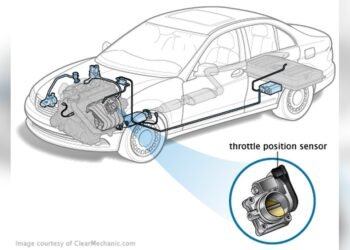A brake light not working on one side can be a real hassle. It is an issue many drivers face at some point.
When one brake light stops working, it can lead to safety concerns. Other drivers might not see your car stopping, which increases the risk of accidents. This common problem can have several causes, from a blown fuse to a faulty bulb or wiring issues.
Understanding the potential reasons behind this can help you address the issue quickly. In this guide, we will explore why your brake light might not be working on one side and what steps you can take to fix it. Stay safe on the road and keep reading to learn more.

Credit: www.youtube.com
Common Causes
A burnt-out bulb often causes a brake light not to work on one side. Faulty wiring or a bad socket are other common issues. Regular checks can help spot these problems early.
A brake light not working on one side is a common issue. It is often due to minor faults. Understanding the root causes can help in fixing the problem quickly.Blown Bulb
A blown bulb is a frequent cause of a brake light failing. Brake light bulbs can burn out over time. Regular use wears them out. Check the bulb first if one brake light stops working. Replacing the bulb is simple. Just make sure to get the right type for your car.Faulty Wiring
Faulty wiring is another common cause of brake light issues. Wires can get damaged or loose. This breaks the circuit. Inspect the wiring for any visible damage. Look for frayed wires or loose connections. Fixing faulty wiring often requires a bit more effort. But it is essential for safety. Both these issues are easy to check and fix. Keeping your brake lights in working order is crucial. It ensures your safety on the road. “`
Credit: www.wikihow.com
Tools Needed
Fixing a brake light that isn’t working on one side requires the right tools. Having these tools handy will make the job easier and ensure it is done correctly. Below are the essential tools you need.
Screwdrivers
You will need screwdrivers to remove the brake light cover. Most vehicles use either a Phillips or flat-head screwdriver. Check which type your vehicle requires before starting. Keeping a set of both types will cover all bases. Screwdrivers are also useful for removing any screws that hold the light assembly in place.
Multimeter
A multimeter is essential for diagnosing electrical issues. It helps you check the voltage and continuity of the brake light circuit. Using a multimeter can pinpoint if the issue is with the bulb, socket, or wiring. First, set the multimeter to the appropriate setting. Then, test the bulb socket for voltage. If there is no voltage, there may be an issue with the wiring.
| Tool | Purpose |
|---|---|
| Screwdrivers | Remove brake light cover and light assembly |
| Multimeter | Check voltage and continuity in the circuit |
Having these tools will ensure you can fix the brake light issue effectively. Make sure to have them ready before you start the repair.
Safety Precautions
Ensuring your vehicle’s brake lights are functional is critical. They alert other drivers when you slow down or stop. If one brake light is not working, it could lead to accidents or fines. Follow these safety precautions to address the issue safely.
Turn Off Ignition
Before working on your brake lights, always turn off the ignition. This step prevents any electrical accidents. It also ensures you won’t get a shock. Turning off the ignition also stops the car from moving accidentally.
Wear Gloves
Always wear gloves when handling car parts. Gloves protect your hands from dirt and grease. They also prevent cuts and abrasions. Wearing gloves ensures a safer and cleaner work environment.
Inspecting The Bulb
When a brake light is not working on one side, it often indicates a simple issue. One common reason is a faulty bulb. Inspecting the bulb can help determine if it’s the root cause.
Removing The Cover
First, locate the brake light cover. This cover protects the bulb. It is usually held by screws or clips. Use a screwdriver to remove the screws. If it has clips, gently pry them open with a flat tool. Be careful not to break them. Once removed, set the cover aside safely.
Checking The Filament
Now, inspect the bulb itself. Look at the filament inside. The filament is a thin wire inside the bulb. It should be intact and unbroken. A broken filament means the bulb is bad. Replace the bulb with a new one. Ensure the new bulb is the correct type for your vehicle. Insert it carefully and reattach the cover. Test the brake light to see if it works.
Replacing The Bulb
Replacing the bulb is often the quickest fix for a brake light not working on one side. This process is easy and takes only a few minutes. You don’t need many tools. Just follow the steps below to get your brake light working again.
Choosing The Right Bulb
First, you need to choose the right bulb. Check your car’s manual. It will list the correct bulb type and model. You can also take the old bulb to an auto parts store. They can help you find the match.
Make sure the new bulb meets your car’s specifications. Using the wrong bulb can cause more issues. Always double-check the model number before buying.
Installing The New Bulb
Once you have the correct bulb, you can start the installation. Open your car’s trunk or hatchback. Locate the brake light cover. You may need a screwdriver to remove the cover. Keep the screws safe.
Carefully remove the old bulb. Be gentle to avoid breaking it. Insert the new bulb into the socket. Ensure it fits snugly. Replace the brake light cover. Tighten the screws back in place.
Test the new bulb. Press the brake pedal and check if the light works. If it lights up, you have successfully replaced the bulb. If not, there may be another issue. Consider consulting a professional for help.

Credit: www.reddit.com
Checking The Fuse
When a brake light is not working on one side, the issue could be a blown fuse. Checking the fuse is a simple process that can save time and money. Fuses protect the car’s electrical system, and a blown fuse can be the culprit.
Locating The Fuse Box
First, locate the fuse box. Most cars have two fuse boxes. One is under the dashboard, near the steering wheel. The other is under the hood, near the battery. Your car’s manual will show the exact locations.
Once you find the fuse box, open it. Inside, there is a diagram that shows what each fuse controls. Find the fuse for the brake lights. The diagram is usually on the fuse box cover or in the owner’s manual.
Testing The Fuse
Next, test the fuse. Use a fuse puller or needle-nose pliers to remove the brake light fuse. Hold the fuse up to the light. Look for a thin wire inside the fuse. If the wire is broken, the fuse is blown.
If you cannot tell by looking, use a multimeter. Set the multimeter to the continuity setting. Place the probes on each end of the fuse. If the meter beeps, the fuse is good. If not, the fuse is blown.
Replace a blown fuse with one of the same rating. The rating is printed on the fuse. Insert the new fuse into the same slot. Test the brake light to see if it works.
Examining The Wiring
If your brake light is not working on one side, wiring issues could be the cause. A faulty wire can disrupt the electrical flow, preventing the brake light from illuminating. It’s essential to inspect the wiring system thoroughly. Here, we will guide you through a visual inspection and how to use a multimeter for testing.
Visual Inspection
Begin with a visual inspection of the wiring. Check for any obvious damage. Look for frayed wires or loose connections. Examine the brake light socket for signs of corrosion. These issues can interrupt the electrical flow. If you find damaged wires, they need replacing. Ensure all connections are secure. Sometimes, a simple reconnection fixes the problem.
Using A Multimeter
If the visual inspection does not reveal the problem, use a multimeter. A multimeter measures electrical current. Set the multimeter to the voltage setting. Test the brake light socket for power. Place the black probe on a ground point. Insert the red probe into the socket. If the multimeter shows no voltage, there is a wiring issue.
Next, check the wiring leading to the socket. Place the probes on the wires. If the reading shows voltage, the socket is faulty. Replace the socket. If there is still no voltage, trace the wiring further back. Test each section. This will help locate the break in the wire. Repair or replace the damaged section.
Using these methods can help pinpoint wiring issues. Fixing these can restore your brake light function on one side.
Seeking Professional Help
Facing an issue with one brake light not working? A professional can quickly diagnose and fix the problem. Trust experts to ensure your safety on the road.
If your brake light is not working on one side, it can be frustrating. You might have tried fixing it yourself without success. Sometimes, the problem needs expert attention. Seeking professional help is the next step.When To Call A Mechanic
If you have checked the bulb and fuse, and the brake light still does not work, call a mechanic. Electrical issues are another reason to seek expert help. If you notice wiring problems, it is best to leave it to a professional. They have the tools and knowledge to fix it safely.Finding A Reliable Technician
Finding the right technician is important. Ask friends or family for recommendations. Read online reviews to learn about others’ experiences. Choose a mechanic with good feedback and a solid reputation. Make sure they have experience with brake light issues. This ensures your car is in good hands. “`Frequently Asked Questions
Why Is My Brake Light Not Working On One Side?
A burnt-out bulb is often the cause. Check and replace it.
How Do I Fix A Brake Light Not Working?
Replace the bulb or check the wiring. A mechanic can help.
Can A Fuse Cause One Brake Light To Fail?
Yes, a blown fuse can cause one brake light to stop working.
How Can I Check If My Brake Light Bulb Is Bad?
Remove the bulb and look for a broken filament. Replace if broken.
What Tools Do I Need To Fix A Brake Light?
A screwdriver and replacement bulb are usually needed. Sometimes, pliers may help.
Conclusion
Fixing a brake light on one side is crucial for safety. Start with checking the bulb. Replace if necessary. Inspect the fuse and wiring for any issues. Clean connections to ensure proper function. If problems persist, consult a professional. Regular maintenance prevents future issues.
Stay safe on the road. Simple steps ensure your brake lights work perfectly. Remember, functioning brake lights keep you and others safe. Keep your vehicle in top shape.















